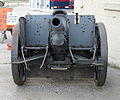7.7 cm field cannon 16
| 7.7 cm field cannon 16 | |
|---|---|
|
|
|
| General Information | |
| Military designation: | 7.7 cm field cannon 16 |
| Manufacturer country: |
|
| Developer / Manufacturer: | Croup , food |
| Production time: | 1916 to 1918 |
| Number of pieces: | 5,086 |
| Technical specifications | |
| Pipe length: | 2,695 m |
| Caliber : |
7.7 cm |
| Caliber length : | L / 35 |
| Cadence : | 5 rounds / min |
| Elevation range: | –10 ° to + 40 ° angular degrees |
| Side straightening area: | 4 ° |
| Furnishing | |
| Sighting device : | Panoramic telescope |
| Closure Type : | Flat wedge |
The 7.7 cm field cannon 16 ( FK 16 for short ) was a light field cannon that was used by the German army in World War I and modified in the Reichswehr , the Belgian and Dutch armies until the 1920s.
history
First World War
The 7.7 cm field cannon 16 replaced the 7.7 cm field cannon 96 nA (nA = new type) in the field artillery and brought about a simplification of production. At the start of operation, however, numerous deficiencies became apparent due to the use of inferior replacement metals, which made repairs in production necessary. Also by similar defects in the manufacture of grenades came increasingly to Rohrkrepierern .
In contrast to the 7.7 cm field cannon 96 nA, the gun was less manoeuvrable due to its greater weight, but achieved a greater range due to the increased caliber length and the larger barrel elevation area.
The 7.7 cm caliber prevented the use of the gun as a prey weapon for allied nations, whose ammunition could not be fired with calibers of 7.5 cm ( France ) or 7.62 cm ( Russia and Great Britain ), while the other way round French or Russian Prey guns could be drilled out and expanded to the 7.7 cm caliber.
Post-war use
Converted to the more common caliber of 7.5 cm, the weapon became the standard gun of the Reichswehr as a 7.5 cm field cannon 16 nA . The artillery of the Armed Forces available to it at the outbreak of war in 1939 still more than 298 guns of this type.
ammunition
The full shot consisted of the projectile with a fuse and the propellant charge with smokeless powder, which was loaded using metal cartridges. In addition to high- explosive projectiles, shrapnel projectiles, anti-tank grenades, smoke projectiles, flares and gas grenades were fired. Impact or adjustable time fuses were used.
photos
swell
literature
- Ian Hogg: 20th Century Artillery. 2nd Edition. Special edition. Gondrom, Bindlach 2001, ISBN 3-8112-1878-6
Web links
Individual evidence
- ↑ accessed on April 1, 2013 ( Memento from April 4, 2013 in the Internet Archive )
- ↑ 7.7 cm le. FK 16 L / 35 ( Memento from April 4, 2013 in the Internet Archive ), accessed on April 1, 2013
- ^ Lueger 1904, accessed April 1, 2013
- ↑ accessed on April 1, 2013 ( Memento from January 20, 2016 in the Internet Archive )






